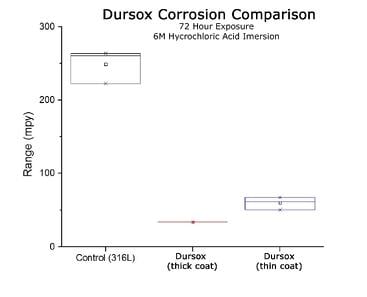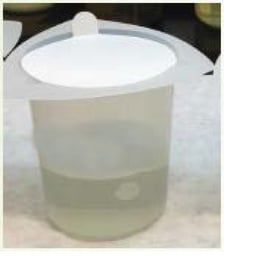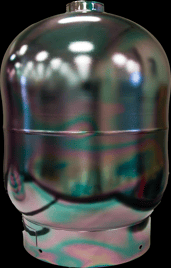
Did you know that SilcoTek® can coat small process tanks and canisters with a high purity corrosion resistant coating? Learn how we do it and how CVD coatings improve the corrosion resistance of tanks, cylinders and canisters.
Containment vessels can hold a secret. Because cylinders, tanks and canisters can't be easily examined, they can corrode, hold onto trace contaminants or react with the contents.
|
In this blog post you will learn:
- How corrosion and reactive samples can impact tank or vessel integrity and contamination
- How Dursan® and Dursox™ coatings can prevent corrosion and contamination
- How cleaning can be detrimental to contamination, reactivity, inertness, and corrosion
- How SilcoTek® lines tanks, sample cylinders and canisters with CVD silicon coatings
|
Be it corrosive or reactive, samples, process fluids, or high purity materials need to be protected from reactive surfaces. Canisters or other containment vessels are typically constructed of stainless steel, carbon steel, or other metal alloys. They do a great job of holding materials under pressure but it's difficult to be sure the tank surface is not reacting with process materials. Problems include:
Inspecting the tank to be sure there's no contamination can be problematic. Inspection probes give a myopic vision of the tank surface and it's easy to miss critical parts of the tank like threads and shoulder areas. Regular cleaning of the interior surface is critical to assuring the surface is clean. But cleaning can have it's own problems including:
- Aggressive cleaners can themselves corrode the surface
- Cleaners can leave a residue that can be reactive
- Cleaners can be inadequate and leave trace process chemical behind to cross contaminate subsequent refills
- "Sticky" process chemical may be left behind
- Process or analytical samples can reside in pitted or rough surfaces or in threaded areas
- Moisture contamination due to aqueous cleaners

Make canister cleaning easier & more effective and while improving corrosion resistance
Applying a CVD coating to the interior of tank surfaces can benefit tank performance and cleaning effectiveness several ways:
- Inert coating eliminates surface reactivity
- Silicon barrier coatings like Dursan® or Silcolloy® bond to tank surfaces and improve corrosion resistance
- Dursan, and other SilcoTek coatings offer non stick properties that prevent "sticky" compound from bonding to the surface, reducing carryover contamination and cross contamination.
- Notak™ coating and Dursan repel moisture, making cleaning more effective and preventing moisture contamination.
Our patented CVD coating process apply non reactive and corrosion resistant silicon to stainless steel (or other metal alloy) canisters to both inside and outside surfaces. Our micro thin silicon barrier coatings do not change the dimension or tolerance of the canister, allowing the customer to easily improve existing tank performance.

Improved tank inertness, purity and corrosion resistance
Test data show a silicon surface bonded to stainless steel can prevent interaction of the flow path material with the tank surface, preventing ion contamination, corrosion resistance and leaching of impurities into the process.
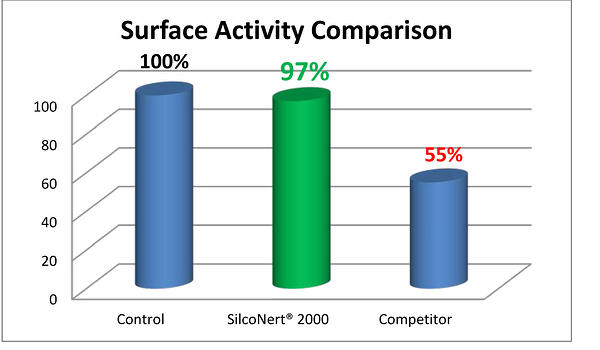

Inertness and purity
SilcoTek's Dursox coating (a silicon-oxide Dursan coating) protects your product from contamination because Dursox® contains no metals. X-Ray photoelectron Spectroscopy (XPS) analysis (below) show no metallic contamination up to 10nm into the Dursox surface. Assuring a contaminant free canister.
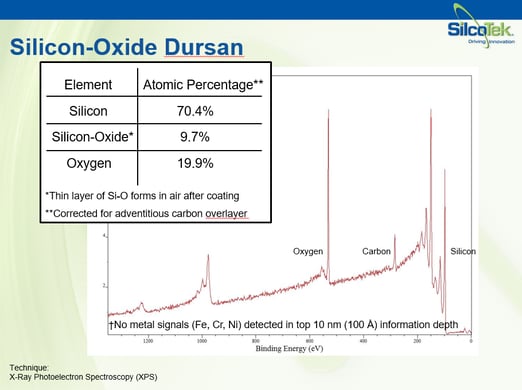
Canister Corrosion resistance
72 hour hydrochloric acid immersion testing show Dursox significantly improves corrosion resistance of tanks and containment vessels. Dursox is a metal free CVD coating that improved corrosion resistance without the use of plastics or metals. More importantly the process liquid (in this case hydrochloric acid, HCl) remained stable and was not contaminated by iron leaching or exposure to the stainless steel surface. The beaker on the right shows a clear HCl liquid. If the stainless steel were attacked by the HCl the liquid would have turned dark green.
Want to see more corrosion data? 
How We Apply Our Coatings To Tanks, Canisters or Sample Cylinders

Our chemical vapor deposition process is not line of sight. That means we can coat not only exposed surfaces but also internal components and surfaces. All areas of the tank both internal and external surfaces including threads are coated. The micro-thin coating does not interfere with threads or other high tolerance surfaces like conflat flanges or compression sealing areas. The coating gas when exposed to metal surfaces under temperature will bond to the tank surface, making a uniform and highly durable coating.
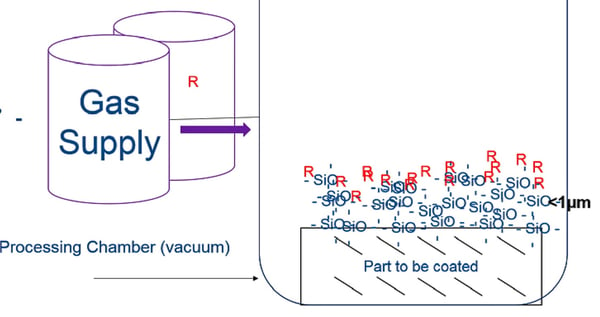
CVD coating applications
SilcoTek® coatings can be applied to a wide range of canister geometries and surfaces
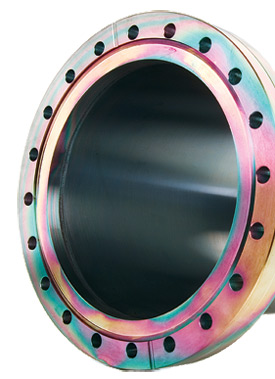 |
- Whole air monitoring canisters
- Sample cylinders for oil and gas applications
- Storage tanks
- Calibration gas cylinders
- Canisters for hydrogen peroxide reactivity in semiconductor ALD
- Tanks and vaporizers for HBr in etch applications
- Tanks for acid cleaners
- Tubing, fitting and valve flow paths
- Conflat, compression, VCR, and other sealing surfaces.
|







